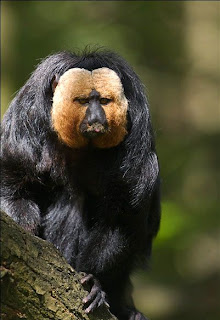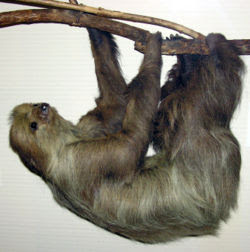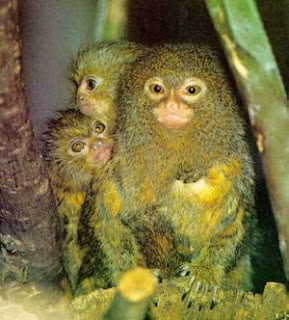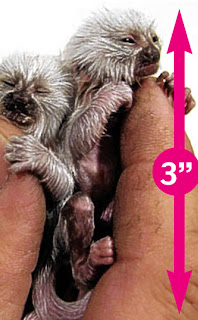skip to main |
skip to sidebar


White-faced Saki Monkey
(Pithecia pithecia)
- The White-faced Saki (Pithecia pithecia), also known as the Guianan Saki and the Golden-faced Saki,
- is a species of saki monkey,
- a type of New World monkey, found in Brazil, French Guiana, Guyana, Suriname, and Venezuela.
- This monkey mostly feed on fruits, but also nuts, seeds, and insects.
Pygmy Marmoset
(Callithrix (Cebuella)
- The Pygmy Marmoset (Callithrix (Cebuella) pygmaea) is a monkey native to the rainforest canopies of western Brazil , southeastern Colombia , eastern Ecuador , and eastern Peru .
- It is one of the smallest primates, with its body length ranging from 14-16 cm (excluding the 15-20 cm tail) and the smallest monkey. Males weigh around 140 g (5 ounces), and females only 120 g ( 4.2 ounces).
- Despite its name, the Pygmy Marmoset is somewhat different from the typical marmosets classified in genus Callithrix. As such, it is accorded its own subgenus, which was formerly recognized as its own genus, Cebuella.
- The Pygmy Marmoset has a tawny coat, and a ringed tail that can be as long as its body.
- Their claws are specially adapted for climbing trees, a trait unique to the species.
- They are omnivorous, feeding on fruit, leaves, insects, and sometimes even small reptiles.
- Much of their diet, however, comes from tapping trees for sap.
- Up to two-thirds of their time is spent gouging tree bark to reach the gummy sap.
- The Pygmy Marmoset has specialized incisors for gouging holes in bark. Unfortunately, because of its small size, and its swift movements, it is very hard to observe in the wild.
- In captivity, the Pygmy Marmoset can live up to 11 years.


Sloth
- Sloths are medium-sized mammals that live in Central and South America belonging to the families Megalonychidae and Bradypodidae, part of the order Pilosa.
- Most scientists call these two families the Folivora suborder, while some call it Phyllophaga.
- Sloths are omnivores. They may eat insects, small lizards and carrion, but their diet consists mostly of buds, tender shoots, and leaves.
- Sloths have made extraordinary adaptations to an arboreal browsing lifestyle.
- Leaves, their main food source, provide very little energy or nutrition and do not digest easily: sloths have very large, specialized, slow-acting stomachs with multiple compartments in which symbiotic bacteria break down the tough leaves.
- As much as two-thirds of a well-fed sloth's body-weight consists of the contents of its stomach, and the digestive process can take as long as a month or more to complete.
- Even so, leaves provide little energy, and sloths deal with this by a range of economy measures: they have very low metabolic rates (less than half of that expected for a creature of their size), and maintain low body temperatures when active (30 to 34 degrees Celsius or 86 to 93 degrees Fahrenheit), and still lower temperatures when resting.
- Sloths mainly live in Cecropia trees.


Emperor Tamarin
(Saguinus imperator)
- The Emperor Tamarin (Saguinus imperator) is a tamarin allegedly named for its similarity with the German emperor Wilhelm II. The name was first intended as a joke, but has become the official scientific name.
- This tamarin lives in the southwest Amazon Basin , in east Peru , north Bolivia and in the west Brazilian states of Acre and Amazonas.
- The fur of the Emperor Tamarin is predominantly grey colored, with yellowish speckles on its chest.
- The hands and feet are black and the tail is brown.
- Outstanding is its long, white mustache, which extends to both sides beyond the shoulders. The animal reaches a length of 24 to 26 cm, plus a 35 cm long tail. It weighs approximately 300 to 400 g.
- This primate inhabits tropical rain forests, living deep in the forest and also in open tree-covered areas. It is a diurnal animal, spending the majority of its days in the trees with quick, safe movements and broad jumps among the limbs.
Proboscis Monkey
- Nasalis larvatus also known as Long-nosed Monkey is a reddish-brown arboreal Old World monkey. It is the only species in monotypic genus Nasalis.
- The most distinctive trait of this monkey is the male's large protruding nose. The purpose of the large nose is unclear, but it has been suggested that it is a result of sexual selection. The female Proboscis Monkey prefers big-nosed male s , thus propagating the trait.
- Males are much larger than females, reaching 72 cm (28 inches) in length, with an up to 75 cm tail, and weighing up to 24 kg (53 pounds). Females are up to 60 cm long, weighing up to 12 kg (26 lb).
- The Proboscis Monkey also has a large belly, as a result of its diet. Its digestive system is divided into several parts, with distinctive gut flora, which help in digesting leaves. This digestive process releases a lot of gas, resulting in the monkey's 'bloated' bellies. A side-effect of this unique digestive system is that it is unable to digest ripe fruit, unlike most other simians. The diet consists mainly of fruits, seeds and leaves.
*Images & Information taken from WIKIPEDIA, the free encyclopedia that anyone can edit ..

















